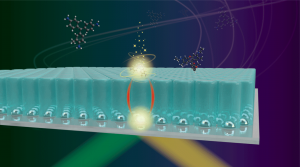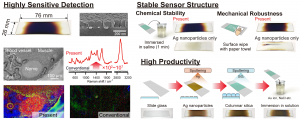Nanoscale layer boosts signal strength in fluorescence and Raman spectroscopy
GA, UNITED STATES, October 29, 2024 /EINPresswire.com/ -- Researchers from Osaka University show that the improvements in signal strength during surface-enhanced fluorescence and Raman spectroscopy can extend even through a nanoscale protective layer. This research may lead to significant improvements in the sensitivity of biosensors and the development of novel point-of-care diagnostics.
While we might picture a biologist as a researcher hunched over a light microscope, carefully scrutinizing a single bacterium, modern scientists have more powerful instruments at their disposal to investigate, at much smaller scales, the internal structures of living cells. Fluorescence and Raman spectroscopy have become indispensable tools for non-invasively monitoring biological processes. Both methods rely on a stimulus light source, usually a laser, to excite either electronic transitions or molecular vibrations for fluorescence and Raman spectroscopy, respectively.
However, the use of fluorescent tags can disrupt the normal functioning of cells, and the signal from Raman spectroscopy can be extremely weak. Using a more powerful laser for longer exposure times can lead to damage to delicate biological molecules. Surface-enhanced variations of these techniques have previously used metal substrates or nanostructures to significantly increase the signal. However, some of these modifications can themselves cause damage to cells.
Now, in a study published in Light: Science & Applications, researchers from Osaka University described a new method for the long-range enhancement of fluorescence and Raman signals using a dense random array of Ag nanoislands1. The analyte molecules are kept separate from metal structures using a 100-nm thick column-structured silica layer. This layer is thick enough to protect the molecules being studied, but at the same time thin enough for the collective electromagnetic oscillations in the metal layer, called plasmons, to enhance the spectroscopic signal. “We demonstrated that the range of influence of plasmons in metals can exceed 100 nanometers, far beyond what conventional theory predicted,” lead author Takeo Minamikawa says.
The team showed that using these biocompatible sensor substrates could increase the signal an amazing ten million times. In addition, because the metal nanostructures never come in direct contact with the molecules being studied, they are ideal for biological systems that could be damaged by conventional methods. “The chemical stability and mechanical robustness of our substrates make them suitable for a wide range of applications, including environmental pollutant detection or medical diagnosis,” senior author Mitsuo Kawasaki says. Additionally, the sensor substrates can be produced quickly and at large scales using a thin-film fabrication technique called sputtering. As a result, new biosensing devices can be more affordable when deployed in industrial and health care settings.
DOI
10.1038/s41377-024-01655-3
Original Source URL
https://doi.org/10.1038/s41377-024-01655-3
Funding information
This work was supported by the PRESTO program (JPMJPR17PC) of Japan Science and Technology Agency (JST), Japan; JSPS KAKENHI (15K12519, 19K22969, 21H01847, 22H00303) from the Japan Society for the Promotion of Science (JSPS), Japan; a research grant from the Research Clusters program of Tokushima University (1802003), Japan.
Lucy Wang
BioDesign Research
email us here
1 https://doi.org/10.1038/s41377-024-01655-3



